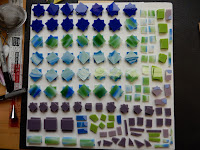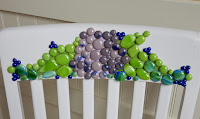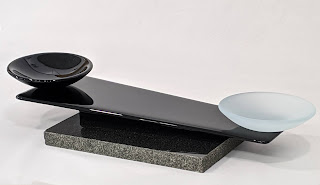Fused Glass Mosaic Painted Chair
 |
| Fused glass mosaic painted chair |
Supplies
Sturdy wooden chairHand sander and sand paper
Tack cloth
Valspar interior/exterior latex
Acrylic paints (I used Martha Stewart paints, which state they are suitable for outdoor use)
Fused glass, all opal colors
GE Silicone II
Brush-on Minwax Polycrylic protective coating
The Process
One thing I will mention up front is that a simple chair with four legs has a surprising number of flat surfaces when you stop to think about it -- or when you have to sand and paint it! I recommend working with a fairly simple chair design (at least the first time around).
 |
| Sanded and ready for painting |
I used an electric hand-sander with a medium grit to remove the existing finish on the chair, and then wiped down the chair with tack cloth to remove all the sanding dust.
 |
| A fresh coat of paint |
I chose a Valspar interior/exterior latex paint with a primer incorporated, so I did not prime the chair first. I painted all surfaces of the chair except for the chairback where I planned to glue the mosaic glass. I didn't paint the chairback because I felt there was less chance of the glued glass pieces coming off -- the glass would be more likely to adhere to bare wood than to paint, and there was less possibility that the glass might adhere to the paint, but the paint would come off the wood some time down the road.
The next day, I applied a second coat of paint.
 |
| Color booklets from the paint store are a great resource for color ideas |
During my visit to the paint store for the latex, I picked up a color booklet containing a color palette I had in mind. This came in handy when I chose the colors for my acrylic paints, and when I chose the glass for the mosaic.
 |
| Fused glass on the kiln shelf and ready to fire |
I cut 1/4" to 1" squares of the different glasses I planned to use, stacked them two pieces high on the kiln shelf, and fired them to a full fuse to create glass circles. Some of the glass that I planned to use for the leaves I also cut in shapes other than squares.
 |
| Testing the mosaic design on paper |
I measured the chairback which came out roughly to 4x14.5", and drew out a pattern for the design on paper. I then laid out the glass pieces, and once I liked the design, glued them to the bare wood using GE Silicone II (which is an excellent glue for bonding glass).
 |
| Mosaic pieces glued in place |
Once I began gluing the pieces in place, I decided to deviate some from my original idea (I felt like the design was getting too busy). I let the glue dry overnight, with the chair lying so that the chairback was flat and level. The next day I painted the remaining bare wood, using some of the colored acrylic paints to fill in the spaces between the glass so that the bare wood did not show through. Once the paint was dry I cleaned up any paint that got on the glass with an exacto blade.
 |
| The painted seat |
The hydrangea design on the seat of the chair was painted with Martha Stewart brand acrylic paints that I found at Michaels. These are supposed to be suitable for indoor or outdoor use and more resistant to fading.
 |
| Completed chairback |
I let the acrylic paint dry a few days and then painted the entire chair with Minwax Polycrylic protective coating, and followed up with a second coat a day later. I used polycrylic rather than polyurethane, because in my research on painting chairs I read it was less likely to yellow (since it is water-based rather than oil-based), and less likely to change the color of the paint underneath.
 |
| Fused glass mosaic chair - Before and After! |
I really enjoyed the challenge of doing something a bit different from my usual fused glass work. I'm very happy with how the chair turned out, despite my limited artistic painting abilities! I hope this information will inspire you to pull out a paint brush, and bring new life back into an old chair!
Dana
Links
The Artists' Gallery, Cache Valley Center for the Arts http://www.artistsgallerylogan.com/
Information on the Chair-ity Challenge (note that this link may eventually expire) http://www.artistsgallerylogan.com/chair-ity-challenge.html
For instructional videos on glass fusing, see Bullseye Glass Educational Videos (click banner below)

